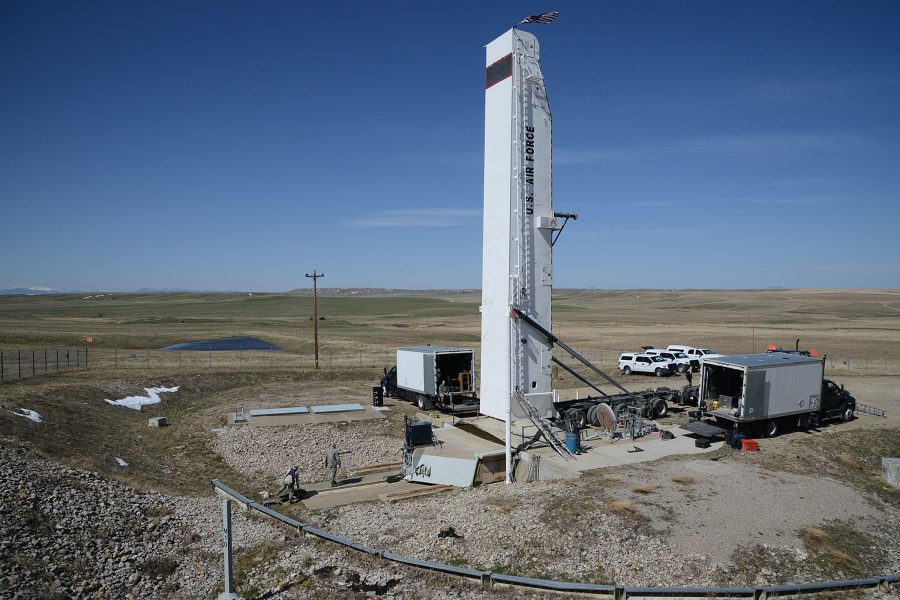Air Force officials are re-examining the infrastructure overhaul that sent costs soaring over plan for the next-generation Sentinel intercontinental ballistic missile upgrade.
USAF leaders have blamed the massive infrastructure overhaul for “critical” cost and schedule misses and now say they are going “line by line” through every requirement to simplify their plans and drive down runaway costs. Pentagon acquisition and sustainment chief William LaPlante had to certify the necessity to continue work on Sentinel after cost-overruns triggered a Nunn-McCurdy Act review.
In certifying Sentinel, however, LaPlante rescinded the program’s Milestone B decision, delaying it from going into engineering and manufacturing development. Instead, he ordered the Air Force to develop a restructuring plan.
Vice Chief of Staff Gen. James C. “Jim” Slife and Assistant Secretary of the Air Force for Acquisition, Technology and Logistics Andrew P. Hunter said at a Defense News conference Sept. 4 that they are making a thorough examination of Sentinel’s requirements.
“I just spent an afternoon going through requirements, line by line,” Slife said. “I mean, this is going to be going on for, you know, for months and months, but absolutely it is down to that level of detail. And it’s not just the top-level requirements. The top-level requirements are fairly easily understood. It’s the derived requirements that actually can become problematic.”
The need to modernize the aging land-based leg of the nuclear triad to provide a strategic deterrent to nuclear war is well understood; it’s the flow of choices that follow that pose the challenges where costs start to multiply, with the projected cost of the program having ballooned from $95.3 billion to $140.9 billion
Each decision builds on a prior one. One requirement choice means “you’re going to need a facility that is this big, and if you’re going to need a facility that big, here’s how much concrete it’s going to take,” Slife explained. “And if it’s going to take that much concrete, you’re going to have to have a workforce. It’s working it all the way down until you understand exactly where the cost drivers are in the program.”
Sentinel is meant to be a complete replacement for the Minuteman system—and while the Minuteman III missiles were first fielded in 1970, the launch centers, support facilities, cabling, and other infrastructure date back even further, to the early 1960s.
“The tendency is to focus on the missile,” Hunter said. “In fact, that was how we did the program initially—we focused on the missile. And we really neglected the complexity of the ground infrastructure.”
Retired Col. Jennifer Reeves, a former ICBM wing commander who is now a senior resident fellow at the Mitchell Institute for Aerospace Studies, said the Air Force only started doing depot-level maintenance on launch and launch control facilities in 2017—more than 50 years after they were first activated.
The failure to think more about ground facilities belies their importance, she said. “An airplane can just go fly in the air anywhere,” she said. “You don’t need the actual structure that the airplane lives in to fly the airplane, which is not the case with the missile. Without the silo, there’s no way to launch it. There’s no way to operate it. They are umbilically connected.”
Hunter said that was clear on a recent visit to Malmstrom Air Force Base, Mont., where he went with Undersecretary of the Air Force Melissa Dalton.
“When you look at the complexity of the current ground infrastructure, and you think about what we ask it to do, we don’t just have a missile,” Hunter said. “We have to have a deterrent. So we have to have a missile where we can respond instantly, at all times, without fail, and in the context of the highest of high-intensity conflicts. … We ask our ground infrastructure essentially to provide most of those capabilities. The missile itself is only a small piece of that puzzle. It’s a very challenging requirement, and it’s instantiated in this ground infrastructure.”
Hunter said the Air Force will bring “a lot of engineering focus” to the ground infrastructure and appeared hopeful that savings would be found.
“[We can] change our design for the ground infrastructure to be simpler, more affordable,” he said. “We’ll work closely together with the operational committee on the requirements to make sure we’re still doing what it takes to deliver nuclear deterrence, but in an affordable way.”
Slife offered an example of the tradeoffs: Security can be physical, or it can rely on manpower. One costs more up front, the other costs more over time. Officials have also previously said the Sentinel launch control facilities will be larger than the Minuteman ones, which could require more construction costs. And Reeves noted that the plan already was to move from five launch control centers per squadron to three, simplifying the overall system.
Still, there is a limit to how much can be simplified. Asked if the service still planned to replace the copper cable used for communications and connectivity with advanced fiber optic cables, Hunter quickly responded that “we do see that as part of the solution going forward.”
